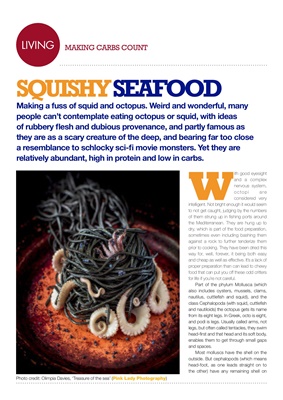
LIVINGLIVING
Making a fuss of squid and octopus. Weird and wonderful, many
people can't contemplate eating octopus or squid, with ideas
of rubbery flesh and dubious provenance, and partly famous as
they are as a scary creature of the deep, and bearing far too close
a resemblance to schlocky sci-fi movie monsters. Yet they are
relatively abundant, high in protein and low in carbs.
MAKING CARBS COUNT
With good eyesight
and a complex
nervous system,
octopi are
considered very
intelligent. Not bright enough it would seem
to not get caught, judging by the numbers
of them strung up in fishing ports around
the Mediterranean. They are hung up to
dry, which is part of the food preparation,
sometimes even including bashing them
against a rock to further tenderize them
prior to cooking. They have been dried this
way for, well, forever, it being both easy
and cheap as well as effective. It's a lack of
proper preparation than can lead to chewy
food that can put you off these odd critters
for life if you're not careful.
Part of the phylum Mollusca (which
also includes oysters, mussels, clams,
nautilus, cuttlefish and squid), and the
class Cephalopoda (with squid, cuttlefish
and nautiloids) the octopus gets its name
from its eight legs. In Greek, octo is eight,
and podi is legs. Usually called arms, not
legs, but often called tentacles, they swim
head-first and that head and its soft body,
enables them to get through small gaps
and spaces.
Most molluscs have the shell on the
outside. But cephalopods (which means
head-foot, as one leads straight on to
the other) have any remaining shell on
SQUISHY SEAFOOD
Photo credit: Olimpia Davies, 'Treasure of the sea' (Pink Lady Photography)